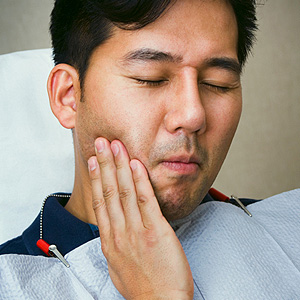Posts for tag: tooth pain
Tooth pain is hard to ignore, especially if it's constant and sharp. You may be able to temporarily treat it at home, but soon you will need to visit the dentist. This is because tooth pain is often related to cavities and requires professional dental treatment. Fortunately, Dr. Jason Campbell of Seaside Dentistry in Virginia Beach, Princess Anne, and Landstown, VA, can help you discover the source of your tooth pain and find treatment—read on to learn more.
Cavities
Cavities occur because of poor oral hygiene. When you fail to brush and floss your teeth, food particles are left behind. Bacteria inside your mouth then turns this debris into acid. The combination of saliva, acid, bacteria, and food particles transforms into plaque. Plaque eliminates tooth enamel, causing holes to form. This creates cavities.
Abscessed Tooth
An abscessed tooth occurs when the soft tissue inside your tooth, called the pulp, dies, becomes inflamed, or is left untreated. As a result, the root of the tooth becomes infected. This will sometimes cause tooth pain.
Teeth Grinding
Bruxism, also known as teeth grinding, occurs when you clench or grind your teeth. Mild bruxism may not cause serious issues. If you have severe bruxism, you can end up with damaged teeth, including tooth pain.
Sinus Infections
Sinus infections may cause tooth pain, specifically in the rear upper teeth, which are located near the sinuses. Schedule an appointment with a Virginia Beach dentist if you experience this type of tooth pain. He will determine if the pain is related to cavities, abscesses, or some other dental issue.
Schedule an Appointment
If you have tooth pain and need a Virginia Beach dentist, contact Dr. Jason Campbell at Seaside Dentistry. We serve Virginia Beach, Princess Anne, and Landstown, VA, areas. Schedule an appointment by calling us at 757-689-4363.

Let's say you have a diseased tooth you think might be on its last leg. It might be possible to save it, perhaps with a significant investment of time and money. On the other hand, you could have it replaced with a life-like dental implant.
That seems like a no-brainer, especially since implants are as close as we have to natural teeth. But you might want to take a second look at salvaging your tooth—as wonderful as implants are, they can't beat the real thing.
Our teeth, gums and jaws form an intricate oral system: Each part supports the others for optimum function and health. Rescuing a troubled tooth could be the best way to preserve that function, and replacing it, even with a dental implant, a less satisfying option.
How we save it will depend on what's threatening it, like advanced tooth decay. Caused by bacterial acid that creates a cavity in enamel and underlying dentin, decay can quickly spread into the tooth's pulp and root canals, and eventually threaten the supporting bone.
We may be able to stop decay and save the tooth with a root canal treatment. During this procedure, we remove diseased tissue from the pulp and root canals through a drilled access hole, and then fill the empty spaces. We then seal the access and later crown the tooth to protect it against future infection.
A second common threat is periodontal (gum) disease. Bacteria in dental plaque infect the outer gums and, like tooth decay, the infection quickly spreads deeper into the root and bone. The disease weakens gum attachments to affected teeth, hastening their demise.
To treat gum disease, we manually remove built-up plaque and tartar (hardened plaque). This deprives the infecting bacteria of their primary food source and “starves” the infection. Depending on the disease's advancement, this might take several cleaning sessions and possible gum surgery to access deep pockets of infection around the root.
Because both of these treatment modalities can be quite in-depth, we'll need to assess the survivability of the tooth. The tooth could be too far gone and not worth the effort and expense to save it. If there is a reasonable chance, though, a rescue attempt for your troubled tooth might be the right option.
If you would like more information on whether to save or replace a tooth, please contact us or schedule an appointment for a consultation. You can also learn more about this topic by reading the Dear Doctor magazine article “Save a Tooth or Get an Implant?”

When they’re introducing a new movie, actors often take a moment to pay tribute to the people who helped make it happen — like, you know, their dentists. At least that’s what Charlize Theron did at the premiere of her new spy thriller, Atomic Blonde.
"I just want to take a quick moment to thank my dentists," she told a Los Angeles audience as they waited for the film to roll. "I don’t even know if they’re here, but I just want to say thank you."
Why did the starring actress/producer give a shout-out to her dental team? It seems she trained and fought so hard in the action sequences that she actually cracked two teeth!
“I had severe tooth pain, which I never had in my entire life,” Theron told an interviewer from Variety. At first, she thought it was a cavity — but later, she found out it was more serious: One tooth needed a root canal, and the other had to be extracted and replaced with a dental implant — but first, a bone grafting procedure was needed. “I had to put a donor bone in [the jaw] to heal,” she noted, “and then I had another surgery to put a metal screw in there.”
Although it might sound like the kind of treatment only an action hero would need, bone grafting is now a routine part of many dental implant procedures. The reason is that without a sufficient volume of good-quality bone, implant placement is difficult or impossible. That’s because the screw-like implant must be firmly joined with the jawbone, so it can support the replacement tooth.
Fortunately, dentists have a way to help your body build new bone: A relatively small amount of bone material can be placed in the missing tooth’s socket in a procedure called bone grafting. This may come from your own body or, more likely, it may be processed bone material from a laboratory. The donor material can be from a human, animal or synthetic source, but because of stringent processing techniques, the material is safe for human use. Once it is put in place your body takes over, using the grafted material as a scaffold on which to build new bone cells. If jawbone volume is insufficient for implants, it can often be restored to a viable point in a few months.
Better yet, when grafting material is placed in the tooth socket immediately after extraction, it can keep most of the bone loss from occurring in the first place, enabling an implant to be placed as soon as possible — even before the end of a movie’s shooting schedule.
Will Atomic Blonde prove to be an action-movie classic? Only time will tell. But one thing’s for sure: When Charlize Theron walks down the red carpet, she won’t have to worry about a gap in her smile.
If you have questions about bone grafting or dental implants, please contact our office or schedule a consultation. You can read more in the Dear Doctor magazine articles “Dental Implant Surgery” and “Immediate Dental Implant.”

Although toothaches are common, not all tooth pain originates from the same source. But regardless of its cause, you need to take prompt action to find out and begin treatment.
Sensitive teeth, for example, usually cause a quick stab of pain when you eat or drink something hot or cold or when you bite down. If the pain lasts only a second or two, you may have a small area of decay in a tooth, a loose filling or an exposed root. The latter often occurs either because of over-aggressive brushing or periodontal (gum) disease. In both cases, the gums may have shrunk back or receded to expose the root surface.
A sharp pain when biting down may be a sign of decay or a loose filling; it could also mean you have a fractured or cracked tooth. For any of those causes, you'll need treatment to repair the problem and relieve the pain.
You may also experience a lingering tooth pain ranging from dull to sharp, or localized to one tooth or seeming to radiate from a general area, such as above the upper jaw. There are a number of possible causes, but two prominent ones are an abscess (a localized area of infection that's become inflamed) or deep decay within the pulp, the heart of a tooth.
This usually calls for a root canal treatment for the affected tooth. In this procedure we drill an access hole into the pulp and clear it of infected and dead tissue. We then fill the empty pulp chamber and root canals with a special filling and seal the access hole. Later, we bond a permanent artificial crown to the tooth to further protect it from re-infection.
Whether your pain is momentary or lingering, dull or sharp, you should see us as soon as possible to determine its cause. You should still see us even if sharp, lingering pain goes away — this could simply mean the infected nerves in the pulp have died but not the infection. The sooner you have the cause of your pain treated, the better your chances of a happy and less costly outcome.
If you would like more information on tooth pain and what to do about it, please contact us or schedule an appointment for a consultation. You can also learn more about this topic by reading the Dear Doctor magazine article “Tooth Pain? Don't Wait!”

Tooth sensitivity can be quite uncomfortable. But the glancing pain you feel may be more than an irritation — it may also be telling you there’s a deeper problem that needs attention.
As with other types of oral pain, tooth sensitivity can be a symptom for a variety of problems. Some of them are relatively minor, while others require immediate attention. It’s important to pay attention to the details about your tooth sensitivity and what they might be indicating you should do about it.
For example, your teeth may be sensitive to hot or cold foods or beverages. If it’s just a momentary pain it generally doesn’t mean an emergency — it could be a small area of decay on a tooth, a loose filling or an exposed root due to gum recession or overaggressive brushing. Besides seeing us for treatment for any decay, you can adjust your brushing habits to more gentle pressure with a soft-bristled brush. Fluoride toothpaste has also been shown to reduce this kind of sensitivity.
If, however, the pain from hot or cold substances lingers, then decay or some form of trauma may have affected the pulp, the innermost layer of a tooth. The pulp is rich in nerve fibers and can become inflamed and irritated from the decay or injury. You should visit us as soon as possible: you may require a root canal treatment that will not only relieve the pain but also save the tooth.
If you notice a sharp pain when biting down on food, it’s possible you have a loose filling or even a cracked tooth. As with inner decay, a fracture requires immediate attention. A loose filling should be easy to repair, but if it’s a fracture you may need extensive treatment to save the tooth or, if beyond salvage, have the tooth removed to make way for dental implant or similar restoration.
The key point is not to delay seeking treatment, especially if the pain is persistent, severe or long-lasting. The sooner you visit us about your tooth sensitivity, the sooner you’ll have solutions to stop the discomfort.
If you would like more information on tooth pain, please contact us or schedule an appointment for a consultation. You can also learn more about this topic by reading the Dear Doctor magazine article “Tooth Pain? Don’t Wait!”
